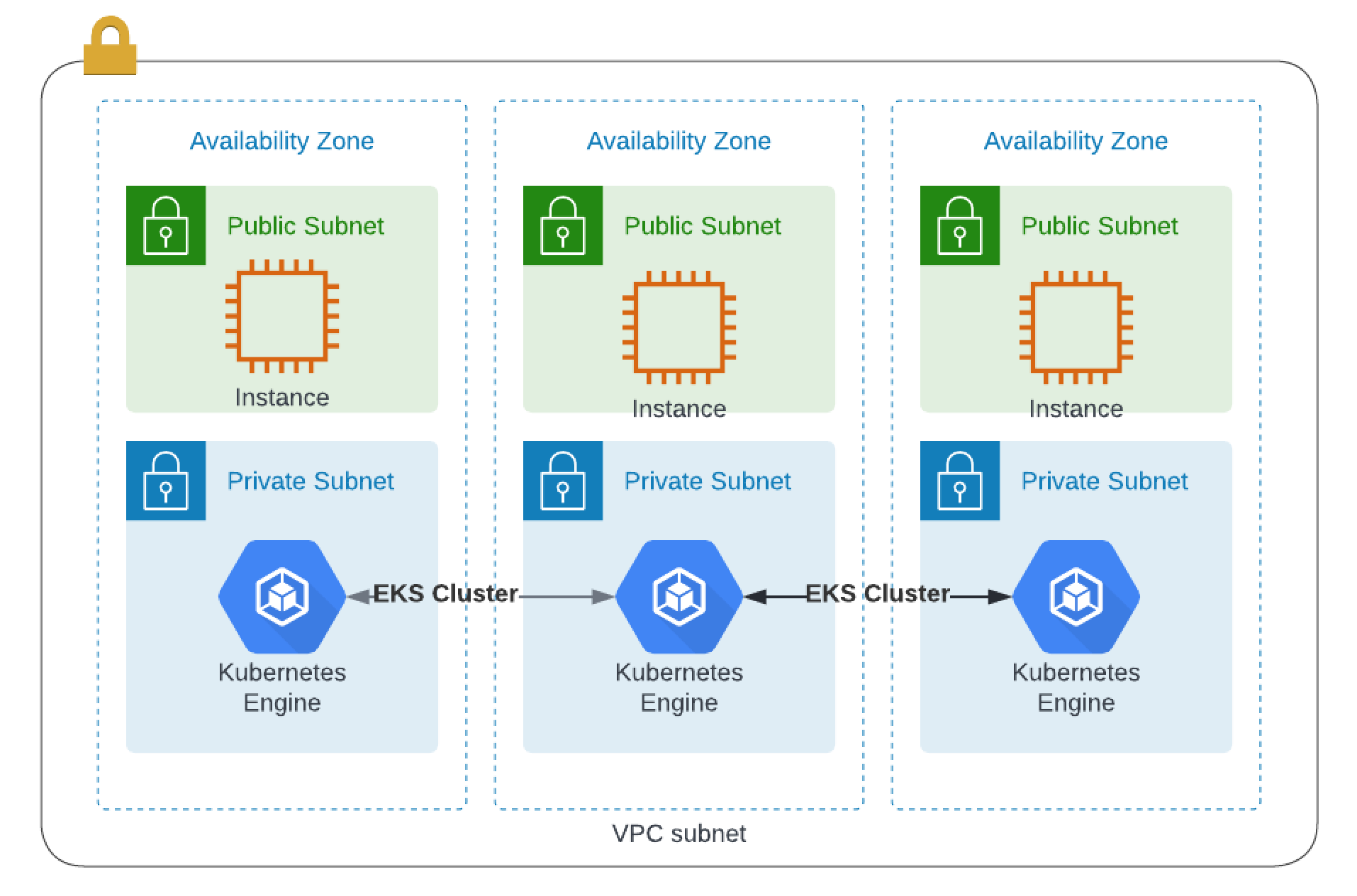This simple guide will give you the ability to spin up a AWS Kubernetes Cluster with a basion server and consul.
The tutorial assumes some basic familiarity with Kubernetes and kubectl but does not assume any pre-existing deployment.
It also assumes that you are familiar with the usual Terraform plan/apply workflow. If you're new to Terraform itself, refer first to the Getting Started tutorial.
For this, you will need:
- an AWS account with the IAM permissions listed on the EKS module documentation,
- configured AWS CLI
- AWS IAM Authenticator
- kubectl installed
- install helm
Use the package manager homebrew to install the AWS CLI.
brew install awscli
After you've installed the AWS CLI, configure it by running aws configure.
When prompted, enter your AWS Access Key ID, Secret Access Key, region and output format.
aws configure
AWS Access Key ID [None]: YOUR_AWS_ACCESS_KEY_ID
AWS Secret Access Key [None]: YOUR_AWS_SECRET_ACCESS_KEY
Default region name [None]: us-east-2
Default output format [None]: json
Your default region can be found in the AWS Web Management Console beside your username. Select the region drop down to find the region name (eg. us-east-1) corresponding with your location.
In your terminal, clone the following repository. It contains the example configuration used in this tutorial.
git clone https://github.com/maniak-academy/consul-aws-eks-terraform
You can explore this repository by changing directories or navigating in your UI.
cd consul-aws-eks-terraform
In here, you will find six files used to provision a VPC, security groups, bastion server and an EKS cluster. The final product should be similar to this:
Once you have cloned the repository, initialize your Terraform workspace, which will download and configure the providers.
terraform init
In your initialized directory, run terraform apply and review the planned actions. Your terminal output should indicate the plan is running and what resources will be created.
terraform apply -auto-approve
This terraform apply will provision a total of all resources (VPC, Security Groups, AutoScaling Groups, Bastion servers EKS Cluster, etc...).
This process should takes up to 10 minutes. Upon successful application, your terminal prints the outputs defined in outputs.tf.
Nex you will need to configure kubectl.
Run the following command to retrieve the access credentials for your cluster and automatically configure kubectl.
aws eks --region $(terraform output -raw region) update-kubeconfig --name $(terraform output -raw cluster_name)
You can then run the command kubectl cluster-info to verify you are connected to your Kubernetes cluster:
$ kubectl cluster-info
Kubernetes control plane is running at https://CCDC5A7DBF4D10997D02A063A1C1CD70.gr7.us-east-2.eks.amazonaws.com
CoreDNS is running at https://CCDC5A7DBF4D10997D02A063A1C1CD70.gr7.us-east-2.eks.amazonaws.com/api/v1/namespaces/kube-system/services/kube-dns:dns/proxy
You can deploy a complete Consul datacenter using the official Consul Helm chart or the Consul K8S CLI. By default, these methods will install a total of three Consul servers as well as one client per Kubernetes node into your EKS cluster. You can review the Consul Kubernetes installation documentation to learn more about these installation options.
To customizer your deployment, you can pass yaml files to be used during the deployment; it will override the helm chart's default values. Take a look at the file provided in the repo helm-consul-values.yaml .
Note:
- If you want to access deploy consul on the internal load balancers in aws you will need to do add the following annotation
'service.beta.kubernetes.io/aws-load-balancer-internal': "true"
Here is the example Helm Chart.
global:
name: consul
datacenter: maniak-dc1
ui:
enabled: true
service:
type: LoadBalancer
connectInject:
enabled: true
default: true
controller:
enabled: true
ingressGateways:
enabled: true
gateways:
- name: ingress-gateway
service:
type: LoadBalancer
terminatingGateways:
enabled: true
You can now deploy a complete Consul datacenter in your Kubernetes cluster using the official Consul Helm chart.
helm repo add hashicorp https://helm.releases.hashicorp.com
Next you can install consul in using the helm chart.
helm install --values helm-consul-values.yaml consul hashicorp/consul --create-namespace --namespace consul --version "0.43.0"
Note: It will take a couple minutes for everthing to spin up.. about 3-5 minutes
Once it has been completed you can run the command kubectl get pods --namespace consul to verify three servers and three clients were successfully created.
$ kubectl get pods --namespace consul
NAME READY STATUS RESTARTS AGE
consul-client-9nrzh 1/1 Running 0 2m30s
consul-client-g8sgr 1/1 Running 0 2m30s
consul-client-kvx6h 1/1 Running 0 2m30s
consul-connect-injector-c47b8bc4f-8pf8m 1/1 Running 0 2m30s
consul-connect-injector-c47b8bc4f-8t4pp 1/1 Running 0 2m30s
consul-controller-5bc8cf7fc9-8hrh2 1/1 Running 0 2m30s
consul-ingress-gateway-6f6c96bd8d-2mts7 2/2 Running 0 2m30s
consul-ingress-gateway-6f6c96bd8d-b6sv5 1/2 Running 0 2m30s
consul-server-0 1/1 Running 0 2m30s
consul-server-1 1/1 Running 0 2m30s
consul-server-2 1/1 Running 0 2m30s
consul-webhook-cert-manager-859c76cdf6-rxlm9 1/1 Running 0 2m30s
Since you enabled the Consul UI in your values file, you can run the command kubectl get services --namespace consul to find the load balancer DNS name or external IP of your UI service.
You will notice that in my helm chart we are using internal load balancer so only internal services will be able to access the gui/cli.
$ kubectl get services --namespace consul
NAME TYPE CLUSTER-IP EXTERNAL-IP PORT(S) AGE
consul-connect-injector ClusterIP 172.20.29.57 <none> 443/TCP 14s
consul-controller-webhook ClusterIP 172.20.56.81 <none> 443/TCP 14s
consul-dns ClusterIP 172.20.67.84 <none> 53/TCP,53/UDP 14s
consul-ingress-gateway LoadBalancer 172.20.219.122 internal-af42aea76dc6943cfa5f882fb9f19cf8-957087530.us-east-2.elb.amazonaws.com 8080:31015/TCP,8443:30352/TCP 14s
consul-server ClusterIP None <none> 8500/TCP,8301/TCP,8301/UDP,8302/TCP,8302/UDP,8300/TCP,8600/TCP,8600/UDP 14s
consul-ui LoadBalancer 172.20.207.209 internal-a2f87cb6ff904447d82f31e8ef1832b0-1886756397.us-east-2.elb.amazonaws.com 80:30794/TCP
To uninstall consul with helm you can run the following command
helm uninstall consul --namespace consul
Remember to destroy any resources you create once you are done with this tutorial. Run the destroy command and confirm with yes in your terminal.
terraform destroy
